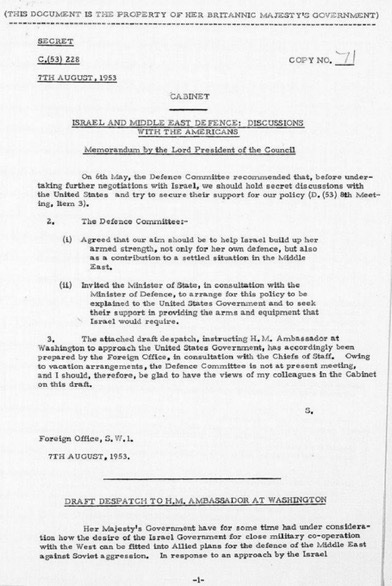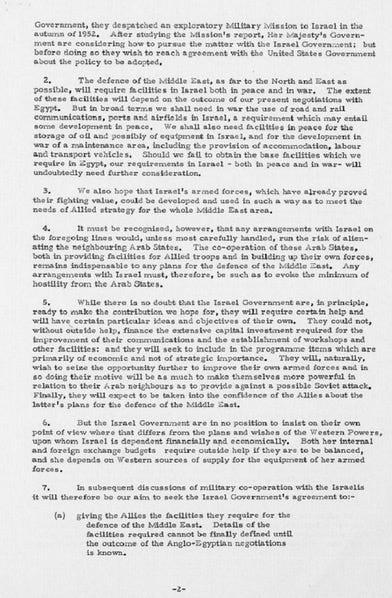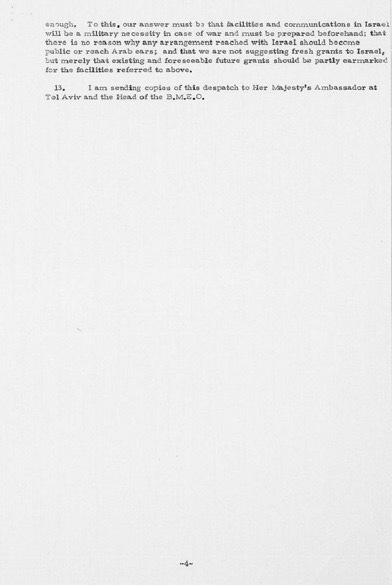Declassified British Documents Reveal Israel’s Strategic Role in Anglo-American Imperial Policy




A declassified British Cabinet document from August 1953 confirms what many have long understood: Israel was never merely a “homeland” for the Jewish people but a strategic Western military outpost engineered to serve Anglo-American interests in the Middle East.
Marked “SECRET,” the document outlines how Israel was designed to function as a militarized Western proxy, financially and militarily dependent on the United States and Britain while serving as a launchpad for Western operations in the region.
Key Revelations from the Document
1. Israel as a Permanent Military Staging Ground
Britain and the U.S. envisioned Israel as an integral part of their long-term military infrastructure:
“The defence of the Middle East will require facilities in Israel in peace and war.”
This reveals that from its inception, Israel was not meant to be just another nation but a permanent logistical and military base for Western powers. Israel’s geography—strategically placed between North Africa, the Levant, and the Persian Gulf—made it an essential Western foothold to counter Arab nationalist movements and Soviet influence.
2. Israel’s Military Buildup Was for Western Strategy, Not Just Self-Defense
While Israel has always justified its militarization as necessary for self-preservation, the document exposes a different motivation:
“We hope Israel’s armed forces could be developed and used in such a way as to meet the needs of Allied strategy for the whole Middle East area.”
This shows that Israel’s armed forces were not just for protecting its borders but were intended as an active extension of Western military power in the region.
3. Israel’s Dependence on Western Powers Was Intentional
The document makes it explicit that Israel would remain subservient to the interests of its Western patrons:
“The Israel Government are in no position to insist on their own point of view where that differs from the plans and wishes of the Western Powers, upon whom Israel is dependent financially and economically.”
This dispels the myth of Israel as an independent actor. Instead, it underscores its structural dependency on Western aid—both financial and military—as a condition for survival. Israel’s foreign policy, economic stability, and military operations were designed to align with Anglo-American interests.
4. Israel Was Expected to Provide Military Access to the West
The document explicitly states Israel’s obligation to serve Western strategic needs:
“Israel must give the Allies the facilities they require for the defence of the Middle East.”
This confirms that Israel’s territory, military infrastructure, and resources were expected to be at the service of the West, reinforcing its role as a forward operating base for Anglo-American strategy.
5. Israel’s Role Extended Beyond Defense—It Was an Active Western Military Agent
Unlike other client states that merely host Western forces, Israel was required to actively participate in military operations beyond its borders:
“Israel must make available [military] formations for employment outside Israel according to plans for the defence of the Middle East.”
This demonstrates that Israel was not merely a buffer state but an active participant in Western military campaigns—a role it has continued to play in the decades since.
6. The West’s “Quid Pro Quo” With Israel—Arms in Exchange for Loyalty
The document lays out the implicit bargain:
“In return, Western Powers will examine sympathetically Israel’s requests for the arms and equipment necessary to enable her to play her correct role.”
This suggests that Western military aid was always conditional—Israel received weapons, funding, and diplomatic support only insofar as it adhered to its assigned role in the broader imperial strategy.
7. Special Focus on Building Israel’s Air Force
Even in 1953, the Western powers emphasized air superiority as Israel’s primary strategic advantage:
“Western help should be concentrated mainly on the building up of Israel’s air force.”
This foreshadowed Israel’s eventual dominance in aerial warfare, which became a key pillar of its military doctrine. Today, Israel’s air force plays a critical role in regional surveillance, targeted assassinations, and preemptive strikes, largely in alignment with Western interests.
A Settler-Colony With a Military Purpose
This declassified document removes any doubt about Israel’s original function. It was not just a Jewish homeland but a Western-engineered military outpost designed to:
Serve as a permanent base for Western operations in the Middle East
Enforce regional military objectives on behalf of Anglo-American interests
Ensure Western control over the region’s geopolitical landscape
Far from being a mere recipient of Western support, Israel was created with the explicit expectation that it would serve as an arm of Western military strategy.
Over 70 years later, this dynamic has not changed. Israel continues to receive unprecedented U.S. military aid, enjoys diplomatic immunity from international accountability, and serves as a testing ground for advanced Western military technology.
The Strategic Role Continues
Policing the Middle East: Israel has repeatedly acted against resistance movements, neutralizing opposition to Western-aligned regimes.
Testing Ground for Western Weapons: Israel has used Gaza and Lebanon as battlefields for testing new military technologies, which are later sold globally.
Regional Instability as a Strategy: By maintaining perpetual tensions, Israel ensures continued Western military engagement in the region.
This 1953 document confirms what has long been evident: Israel was never merely about Jewish self-determination—it was always a Western military project.
Supporting References
1. AT Dessí (2018) discusses how the Reagan administration normalized Israel as a strategic asset during the Cold War, drawing on recently declassified documents. The study explores how Israel was leveraged within Western strategic calculations. Read more here.
2. D Adamsky (2017) examines Israeli deterrence strategies and their integration into Western military thought. The study notes that many strategic documents remain classified, but those available confirm Israel’s role in broader Western defense planning. Read more here.
3. D Meridor & R Eldadi (2019) present Israel’s National Security Doctrine, which reflects on Israel’s alignment with Western defense interests and its strategic role in the Middle East. Read more here.
4. E Ben Aharon (2020) analyzes Israel’s Cold War positioning and its alignment with the Western bloc. Declassified records confirm that Israel strategically sided with the West for military and economic support. Read more here.
5. D Marwecki (2020) discusses Israel’s role in post-war European and Western strategy, utilizing declassified files to analyze Germany’s relationship with Israel in terms of strategic interest. Read more here.
6. Z Maoz (2009) provides a critical analysis of Israel’s security and foreign policy, citing declassified materials that reveal Western support for Israel as a strategic regional asset. Read more here.
7. Z Levey (2004) examines Israeli foreign strategy in Africa using declassified documents, showing how Israel positioned itself within the East-West divide. Read more here.
8. E Rettig & Z Rubinovitz (2024) use declassified British, Israeli, and U.S. materials to explain how Israel influenced Western energy and military strategies in the 1970s. Read more here.
9. CD Freilich (2018) discusses Israeli national security strategy, referencing both classified and declassified materials to highlight Israel’s embedded role in Western defense planning. Read more here.
10. U Bialer (1990) details Israel’s early foreign policy orientation between East and West, based on government declassified documents. Read more here.




Shared on facebook.
Exactly.